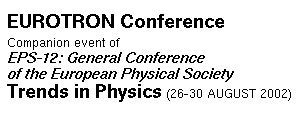 |
 |
 |
2Experimental Solid State Group, Blackett Labs, Imperial College, London SW7 2BW (UK)
We have investigated the effect of guest-host separation and temperature on the rate of Förster transfer and energy migration between two commercially important fluorescent polymers, namely poly(9,9-dioctylfluorene) (F8) and poly(9,9-dioctylfluorene-co-benzothiadiazole) (BT). We find that increasing the average distance between guest (BT) and host (F8) molecules results in a reduced transfer rate, attributed to the decrease in strength of the dipole-dipole interaction. Reducing the temperature has no effect on Förster transfer, but does reduce the energy migration rate.
The Förster radius, defined as the distance between molecules at which excitations are as likely to undergo Förster transfer as decay via any other route, is still a subject of some debate in these systems. Calculations of this distance from spectral overlap data suggests that in a blend of F8 and BT the Förster radius is approximately 5nm. Here we present experimental data from picosecond time-resolved studies on two such systems.
Simple blends of varying concentrations from 50% to 0.01% BT were prepared by spin-coating from solution. The excitation dynamics of the host were observed over a range of temperatures, and were found to exhibit both Förster transfer and, in the case of lower guest concentration blends, energy migration [1].
More complex layered structures were then fabricated by first spin-coating F8 onto a substrate, then depositing an optically inert spacer layer via the Langmuir-Blodgett technique. Finally, BT was spin-coated onto a second substrate and transferred on top of the spacer layer using a water floating technique, to form a sandwich type structure. By varying the number of monolayers in the inert spacer, control over the Förster transfer mechanism was achieved (without affecting energy migration in the F8), and the Förster radius calculated.
[1] A. R. Buckley, M. D. Rahn, J. Hill, J. Cabanillas-Gonzalez, A. M. Fox, D. D. C. Bradley, Chem. Phys. Lett. 339, 331-336 (2001)
The following files are available:
- abstracthill.pdf [11409 bytes]
- abstracthill.doc [23040 bytes]
Eurotron Conference is supported by European Commission, High-Level Scientific Conferences